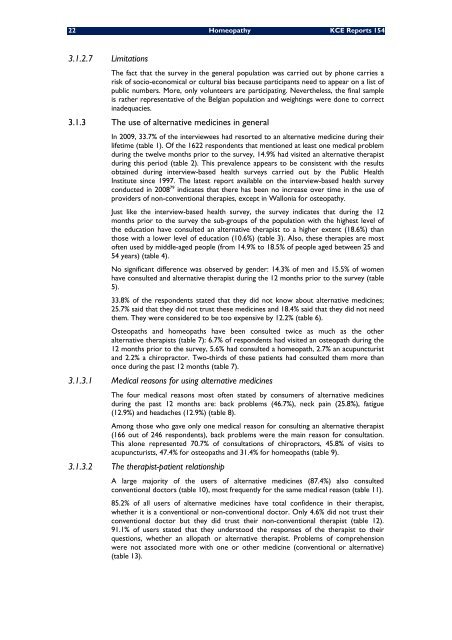Etat des lieux de l'homéopathie en Belgique - KCE
Etat des lieux de l'homéopathie en Belgique - KCE
Etat des lieux de l'homéopathie en Belgique - KCE
You also want an ePaper? Increase the reach of your titles
YUMPU automatically turns print PDFs into web optimized ePapers that Google loves.
22 Homeopathy <strong>KCE</strong> Reports 154<br />
3.1.2.7 Limitations<br />
The fact that the survey in the g<strong>en</strong>eral population was carried out by phone carries a<br />
risk of socio-economical or cultural bias because participants need to appear on a list of<br />
public numbers. More, only volunteers are participating. Nevertheless, the final sample<br />
is rather repres<strong>en</strong>tative of the Belgian population and weightings were done to correct<br />
ina<strong>de</strong>quacies.<br />
3.1.3 The use of alternative medicines in g<strong>en</strong>eral<br />
In 2009, 33.7% of the interviewees had resorted to an alternative medicine during their<br />
lifetime (table 1). Of the 1622 respon<strong>de</strong>nts that m<strong>en</strong>tioned at least one medical problem<br />
during the twelve months prior to the survey, 14.9% had visited an alternative therapist<br />
during this period (table 2). This preval<strong>en</strong>ce appears to be consist<strong>en</strong>t with the results<br />
obtained during interview-based health surveys carried out by the Public Health<br />
Institute since 1997. The latest report available on the interview-based health survey<br />
conducted in 2008 79 indicates that there has be<strong>en</strong> no increase over time in the use of<br />
provi<strong>de</strong>rs of non-conv<strong>en</strong>tional therapies, except in Wallonia for osteopathy.<br />
Just like the interview-based health survey, the survey indicates that during the 12<br />
months prior to the survey the sub-groups of the population with the highest level of<br />
the education have consulted an alternative therapist to a higher ext<strong>en</strong>t (18.6%) than<br />
those with a lower level of education (10.6%) (table 3). Also, these therapies are most<br />
oft<strong>en</strong> used by middle-aged people (from 14.9% to 18.5% of people aged betwe<strong>en</strong> 25 and<br />
54 years) (table 4).<br />
No significant differ<strong>en</strong>ce was observed by g<strong>en</strong><strong>de</strong>r: 14.3% of m<strong>en</strong> and 15.5% of wom<strong>en</strong><br />
have consulted and alternative therapist during the 12 months prior to the survey (table<br />
5).<br />
33.8% of the respon<strong>de</strong>nts stated that they did not know about alternative medicines;<br />
25.7% said that they did not trust these medicines and 18.4% said that they did not need<br />
them. They were consi<strong>de</strong>red to be too exp<strong>en</strong>sive by 12.2% (table 6).<br />
Osteopaths and homeopaths have be<strong>en</strong> consulted twice as much as the other<br />
alternative therapists (table 7): 6.7% of respon<strong>de</strong>nts had visited an osteopath during the<br />
12 months prior to the survey, 5.6% had consulted a homeopath, 2.7% an acupuncturist<br />
and 2.2% a chiropractor. Two-thirds of these pati<strong>en</strong>ts had consulted them more than<br />
once during the past 12 months (table 7).<br />
3.1.3.1 Medical reasons for using alternative medicines<br />
The four medical reasons most oft<strong>en</strong> stated by consumers of alternative medicines<br />
during the past 12 months are: back problems (46.7%), neck pain (25.8%), fatigue<br />
(12.9%) and headaches (12.9%) (table 8).<br />
Among those who gave only one medical reason for consulting an alternative therapist<br />
(166 out of 246 respon<strong>de</strong>nts), back problems were the main reason for consultation.<br />
This alone repres<strong>en</strong>ted 70.7% of consultations of chiropractors, 45.8% of visits to<br />
acupuncturists, 47.4% for osteopaths and 31.4% for homeopaths (table 9).<br />
3.1.3.2 The therapist-pati<strong>en</strong>t relationship<br />
A large majority of the users of alternative medicines (87.4%) also consulted<br />
conv<strong>en</strong>tional doctors (table 10), most frequ<strong>en</strong>tly for the same medical reason (table 11).<br />
85.2% of all users of alternative medicines have total confi<strong>de</strong>nce in their therapist,<br />
whether it is a conv<strong>en</strong>tional or non-conv<strong>en</strong>tional doctor. Only 4.6% did not trust their<br />
conv<strong>en</strong>tional doctor but they did trust their non-conv<strong>en</strong>tional therapist (table 12).<br />
91.1% of users stated that they un<strong>de</strong>rstood the responses of the therapist to their<br />
questions, whether an allopath or alternative therapist. Problems of compreh<strong>en</strong>sion<br />
were not associated more with one or other medicine (conv<strong>en</strong>tional or alternative)<br />
(table 13).

















